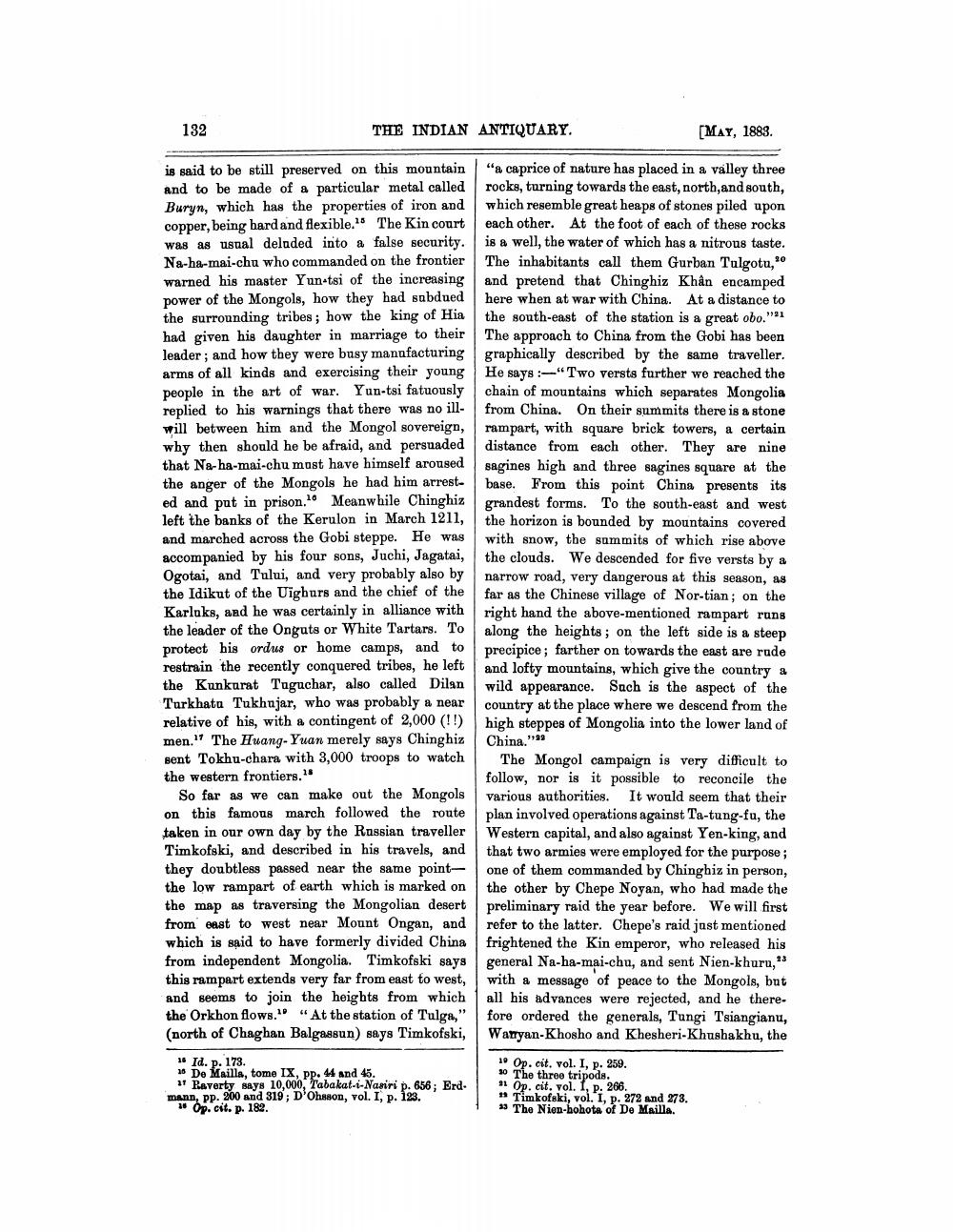________________
132
THE INDIAN ANTIQUARY.
[MAY, 1883.
is said to be still preserved on this mountain and to be made of a particular metal called Buryn, which has the properties of iron and copper, being hard and flexible. The Kin court was as usual deluded into a false security. Na-ha-mai-chu who commanded on the frontier warned his master Yun-tsi of the increasing power of the Mongols, how they had subdued the surrounding tribes; how the king of Hia had given his daughter in marriage to their leader; and how they were busy mannfacturing arms of all kinds and exercising their young people in the art of war. Yun-tsi fatuously replied to his warnings that there was no illwill between him and the Mongol sovereign, why then should he be afraid, and persuaded that Na-ha-mai-chu must have himself aroused the anger of the Mongols he had him arrested and put in prison. Meanwhile Chinghiz left the banks of the Kerulon in March 1211, and marched across the Gobi steppe. He was accompanied by his four sons, Juchi, Jagatai, Ogotai, and Tului, and very probably also by the Idikut of the Uighurs and the chief of the Karluks, and he was certainly in alliance with the leader of the Onguts or White Tartars. To protect his ordus or home camps, and to restrain the recently conquered tribes, he left the Kunkurat Tuguchar, also called Dilan Tarkhatu Tukhujar, who was probably a near relative of his, with a contingent of 2,000 (!!) men." The Huang-Yuan merely says Chinghiz sent Tokhu-chara with 3,000 troops to watch the western frontiers."
So far as we can make out the Mongols on this famous march followed the route taken in our own day by the Russian traveller Timkofski, and described in his travels, and they doubtless passed near the same point, the low rampart of earth which is marked on the map as traversing the Mongolian desert from east to west near Mount Ongan, and which is said to have formerly divided China from independent Mongolia. Timkofski says this rampart extends very far from east to west, and seems to join the heights from which the Orkhon flows. "At the station of Tulga," (north of Chaghan Balgassun) says Timkofski,
"a caprice of nature has placed in a valley three rocks, turning towards the east, north and south, which resemble great heaps of stones piled upon each other. At the foot of each of these rocks is a well, the water of which has a nitrous taste. The inhabitants call them Gurban Talgotu," and pretend that Chinghiz Khân encamped here when at war with China. At a distance to the south-east of the station is a great obo." The approach to China from the Gobi has been graphically described by the same traveller. He says :-"Two versts further we reached the chain of mountains which separates Mongolia from China. On their summits there is a stone rampart, with square brick towers, a certain distance from each other. They are nine sagines high and three sagines square at the base. From this point China presents its grandest forms. To the south-east and west the horizon is bounded by mountains covered with snow, the summits of which rise above the clouds. We descended for five versts by a narrow road, very dangerous at this season, as far as the Chinese village of Nor-tian; on the right hand the above-mentioned rampart runs along the heights ; on the left side is a steep precipice; farther on towards the east are rude and lofty mountains, which give the country a wild appearance. Sach is the aspect of the country at the place where we descend from the high steppes of Mongolia into the lower land of China."
The Mongol campaign is very difficult to follow, nor is it possible to reconcile the various authorities. It would seem that their plan involved operations against Ta-tung-fu, the Western capital, and also against Yen-king, and that two armies were employed for the purpose; one of them commanded by Chinghiz in person, the other by Chepe Noyan, who had made the preliminary raid the year before. We will first refer to the latter. Chepe's raid just mentioned frightened the Kin emperor, who released his general Na-ha-mai-chu, and sent Nien-khuru," with a message of peace to the Mongols, but all his advances were rejected, and he therefore ordered the generals, Tungi Tsiangianu, Waryan-Khosho and Khesheri-Khushakhu, the
1. Id. p. 173. 16 De Mailla, tome IX, pp. 44 and 45.
11 Reverty says 10,000, Tabakat-i-Nasiri p. 656; Erdmann, pp. 200 and 319; D'Ohnson, vol. I, p. 123.
* Op. cit. p. 182.
10 Op. cit. vol. I, p. 259. 30 The three tripods. *1 Op. cit. vol. 1, p. 266. # Timkofski, vol. I, p. 272 and 273. 33 The Nien-bohota of De Mailla.




